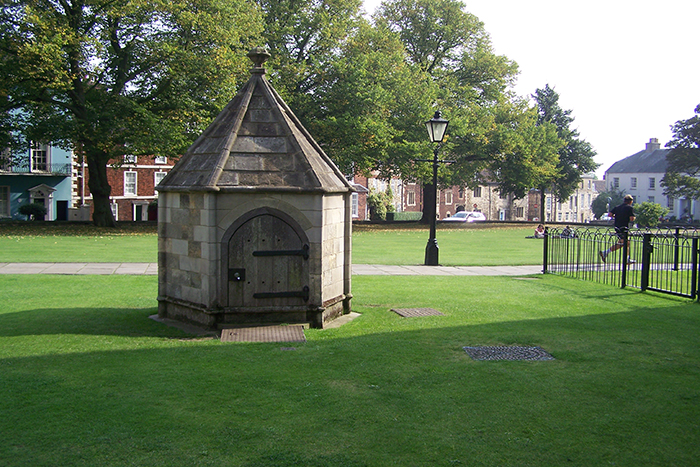
Water tanks built to fight fires in uphill Lincoln
In this latest article examining the work of The Survey of Lincoln, Geoff Tann looks at some unexpected water features in uphill Lincoln.
Until Westgate water tower was built in 1911 uphill Lincoln experienced severe problems with inadequate water mains pressure for effective firefighting.
Press reports describe the problems caused by a fire in Minster Yard on 23 October 1909, probably caused by a painter’s blowlamp. Three houses were affected, with two left gutted by the blaze. The first fire engine to arrive was horse-drawn and took about ten minutes as a result of a shortage of available horses.
The mains had too little pressure for its manually operated pumps and there was an hour’s wait for a steam-operated tender to become available. The fire burnt for another hour and was eventually extinguished with help from water pumped from a 30,000-gallon underground tank maintained by the cathedral at its east end, later covered by an ‘octagonal’ (actually six-sided) stone structure.
During the Second World War, when British towns and cities were being hit by incendiary bombs, schemes were prepared to enable fire-fighting in Lincoln in case of an attack. Particular care was taken to protect the historic structures of the cathedral, castle and buildings close to them. A test of the cathedral system in June 1940 found that its pump could send jets of water to extinguish fires, but the Corporation also owned a Sulzer pump which would perform better still.
A large reservoir was constructed specifically in response to the incendiary bombs threat, beside the castle outer wall in Castle Hill. This site was undergoing landscaping and redevelopment following the purchase of the property by the City Council in 1938 and the demolition of Castle House.
The Council had approved plans to create toilets and a 30-vehicle carpark, with a garden extending to the castle wall. The toilet and car park plans were indefinitely postponed on 1 April 1941, and instead the site was used for a dammed water tank which was filled with water. In early 1942, over half a mile of six-inch diameter piping was installed to pump water from Water Lane up Mint Lane, Mint Street, Hungate and Michaelgate to the Castle Square tank.
A 1942 plan in the Cathedral Works Department archives marks a large 25,000-gallon underground tank to the east of the cathedral, and a slightly smaller above-ground tank, situated between Eastgate and Priorygate. Another open storage tank to the north of the cathedral, at the corner of Minster Yard and Eastgate, opposite James Street, is not shown on that plan.
The Castle Square tank (and another sited to the north of the cathedral) formed part of a scheme consisting of 40 tanks holding between 5,000 and 300,000 gallons which were spread around the city but mostly uphill. All of the tanks were linked to others by pipes, and pumps allowed water to be transferred around the upper city. A bomb which fell at Cold Bath House at the Arboretum was the closest to land near to the cathedral although blast damage dislodged lead and broke panes of glass in the nave windows on several occasions.
In Castle Square, it is still possible to see most of the concrete and concrete-rendered thick walls of the tank, roughly cut through by the later toilet block and the car park entrance. The stubs of railings on the eastern wall still remain, and the concrete car park surface may be the tank floor.
To find out more about The Survey of Lincoln and its work, see www.thesurveyoflincoln.co.uk.
Pictured top is the six-sided structure located to the east of the cathedral, which marks the site of an underground reservoir, while below is Lincoln’s Castle Hill car park, formerly the location of a Second World War reservoir. Photos: Geoff Tann.
